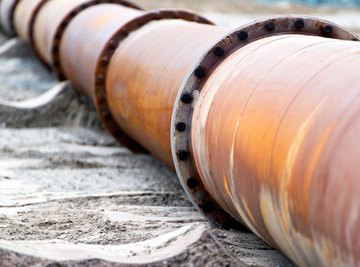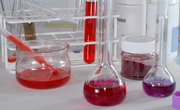
An oxidation-reduction reaction, or "redox" reaction for short, involves the exchange of electrons between atoms. In order to determine what happens to which elements in a redox reaction, you must determine the oxidation numbers for each atom before and after the reaction. Oxidation numbers represent the potential charge of an atom in its ionic state. If an atom's oxidation number decreases in a reaction, it is reduced. If an atom's oxidation number increases, it is oxidized.
General Oxidation Number Rules
In order to determine the oxidation number of an atom, you must consider a number of general rules. First, the oxidation number of elemental substances is zero. Second, the oxidation number of an ion containing only one atom is equal to the charge of that ion. Third, the sum of the oxidation numbers of the elements in a compound equal zero. Fourth, the oxidation numbers of the elements in an ion with multiple atoms add to the overall charge.
Element-Specific Oxidation Number Rules
A number of elements or groups of elements have predictable oxidation numbers. Consider the following rules as well. First, the oxidation of a Group 1A ion is +1. Second, the oxidation number of a Group 2A ion is +2. Third, the oxidation number of hydrogen is typically +1, unless it combines with a metal. In such a case, it has an oxidation number of -1. Fourth, the oxidation number of oxygen is typically -2. Fifth, the oxidation number of a fluorine ion in a compound is always -1.
Determining Oxidation Numbers
The oxidation number rules help determine the oxidation numbers of unknown elements in the chemical equation. For example, consider the following chemical equation:
Zn + 2HCl --> Zn2+ + H2 +2Cl-
On the left hand side, zinc has an oxidation number of zero. Hydrogen is bonded to a nonmetal and therefore has oxidation number of +1. The net charge of HCl is zero, therefore chlorine has an oxidation number of -1. On the right hand side, zinc has an oxidation number of +2, which is identical to its ionic charge. Hydrogen occurs in its elemental form and therefore has an oxidation number of zero. Chlorine still has an oxidation number of -1.
Comparing the Two Sides
In order to determine what is oxidized and what is reduced in a redox reaction, you must track the changes in oxidation numbers across the two sides of the equation. In the equation above, zinc began with zero and ended at +2. Hydrogen began at +1 and ended at zero. Chlorine stayed at -1. Zinc's oxidation number increased. Therefore, zinc was oxidized. Hydrogen's oxidation number decreased. Therefore, hydrogen was reduced. Chlorine experienced no change in oxidation number and therefore was neither reduced nor oxidized.
References
About the Author
Serm Murmson is a writer, thinker, musician and many other things. He has a bachelor's degree in anthropology from the University of Chicago. His concerns include such things as categories, language, descriptions, representation, criticism and labor. He has been writing professionally since 2008.
